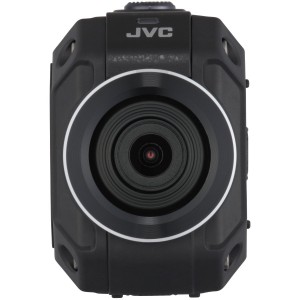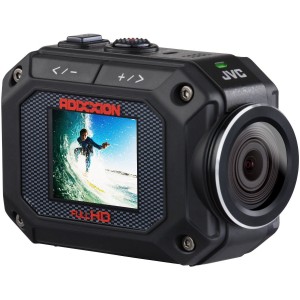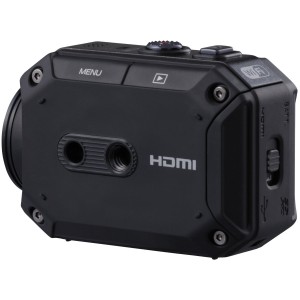JVC Adixxion 2 vs GoPro
The JVC Adixxion GC-XA2 is JVC’s second serious foray into the world of action cameras, following up on the GCXA1 from 2012. It represents a quite different approach to the GoPro – it is inherently waterproof and protected without a case though (as discussed further below) not quite as rugged as the GoPro is with its case on, and it features a built-in LCD screen for reviewing footage.
The overall design of the Adixxion is in fact vaguely reminiscent of a traditional-style camcorder – a lens at the front, mounted on a roughly rectangular body. The screen is on the right hand side, and is fixed at 90 degrees to the lens (with no ability to fold it out), so there is limited capability for the GC-XA2 to be used like a conventional video, with camera being held out in front of the user and the screen used for framing (unlike a GoPro with the optional backpack screen attached). However, the screen is useful for reviewing footage that has already been shot, and for navigating through the various camera menus – and, of course, it has to be remembered that as standard, a GoPro has no screen at all. However, both the GoPro and the Adixxion have built in wifi which works with a iPhone / Android phone app, and allows the camera to be controlled from the phone and the footage to be reviewed. As such, assuming you have access to such a phone, the screen on the JVC (and indeed the lack of screen on the GoPro) may not be a major consideration.
The Adixxion GC-XA2 has a maximum video resolution of 1080p at 60fps, with a field of view of 137 degrees. That makes it broadly comparable with the GoPro 3+ Silver edition – it has the same 1080p/60 resolution, but a notably wider 170 degree field of view. The Adixxion also has the ability to shoot 120fps at 720p resolution – again, on a par with the GoPro 3+ Silver. As for still photographs, the GC-XA2 boasts a 8 megapixel sensor, and can take up to burst at up to 15fps – slightly higher than the GoPro’s 10fps, though those pics are at a slightly higher resolution of 11 megapixels. Overall, the two cameras have very similar technical specifications (though of course the range topping GoPro Hero 3+ Black boasts higher still resolution and frame rates).
In terms of mounting options, the Adixxion has been designed with dual standard fit tripod mounts – one on the base, and one on the left side, allowing it to be mounted either on top or to the right of something – be it a handlebar, helmet, or seat post. In the box, the camera ships with what JVC call a “wide flexible mount” – this is basically a tripod attachment on an adhesive pad, which lends itself to being stuck onto a flat or gently curved surface like a helmet. However, clearly this can only be stuck somewhere once, so it is likely that users will want to purchase other mounts. To this end, JVC also sell a range of other mounting options, including a chest mount, an attachment to mount on a goggle strap, a roll bar mount and a suction cup mount. In addition, given that the Adixxion utilises a standard tripod thread, it is possible to use any third party tripod mount directly with the camera – for example, the Fat Fat Gecko suction cup mount. However, what is currently missing from the range of mounts is an elastic-based helmet mount which can be transferred from helmet to helmet (or indeed person to person) – GoPro have the Headstrap Mount which is ideal for these purposes. In addition, the tripod mount doesn’t allow the camera to be tilted up or down when it is mounted upright using the bottom mount – so, for example, using the chest mount when cycling can lead to the field of view being too low and only of the front wheel. This can be potentially resolved by fitting an additional ball head between the mount and the camera, but this further complicates the mount. It’s an issue that the GoPro avoids altogether with its hinged mount arrangement.
 One of the key design differences between the GoPro range and the JVC Adixxion is the external case (or lack thereof in the case of the Adixxion. JVC claims that the camera is waterproof to a depth of 5m (16ft), and also shockproof for drops of 2m (6.5ft), as well as being dust-proof and freeze-proof to -10 C. A marine case is also available which increases the waterproof capabilities to 40m. Meanwhile however, the GoPro in its supplied case is waterproof all the way down to 60m. While GoPro don’t give a specific shockproof rating, there are enough videos out there showing GoPros recording (and surviving) huge drops (such as this one from a plane into a pig pen!) that we are confident it is considerably in excess of the 2m. The use of a case as standard also means that if the external lens of the GoPro ever gets scratched, it can be resolved by replacing the case for a relatively modest price. This is a risk with the Adixxion’s approach – JVC do sell a lens protector, but users report that this can lead to fogging and distortion, so it is not an ideal solution. Of course, out of its case the GoPro is very vulnerable, so care does need to be taken when changing SD card or batteries.
One of the key design differences between the GoPro range and the JVC Adixxion is the external case (or lack thereof in the case of the Adixxion. JVC claims that the camera is waterproof to a depth of 5m (16ft), and also shockproof for drops of 2m (6.5ft), as well as being dust-proof and freeze-proof to -10 C. A marine case is also available which increases the waterproof capabilities to 40m. Meanwhile however, the GoPro in its supplied case is waterproof all the way down to 60m. While GoPro don’t give a specific shockproof rating, there are enough videos out there showing GoPros recording (and surviving) huge drops (such as this one from a plane into a pig pen!) that we are confident it is considerably in excess of the 2m. The use of a case as standard also means that if the external lens of the GoPro ever gets scratched, it can be resolved by replacing the case for a relatively modest price. This is a risk with the Adixxion’s approach – JVC do sell a lens protector, but users report that this can lead to fogging and distortion, so it is not an ideal solution. Of course, out of its case the GoPro is very vulnerable, so care does need to be taken when changing SD card or batteries.Both the Adixxon 2 and the GoPro produce excellent, high definition video output. The slightly narrower field of view of the JVC is apparent when reviewing the footage – there is less of the classic fish eye effect that we have come to associate with the GoPro, and as such a bit less of the feeling of the scenery wrapping around and whizzing past the camera. The JVC features image stabilisation technology, but to be honest we remain unconvinced of how useful this is on an action camera – while it is great at smoothing out small jiggles, it is never going to be able to correct the bumps and knocks that are typical of a body-mounted camera. In this regard, the GoPro’s super wide lens has another benefit in helping to minimise the effect of such bumps on the footage. Overall, the footage from both camera is excellent, and the choice between the two is to a large extent this is personal preference – on balance we slightly prefer the GoPro’s super wide footage, but other may prefer the slightly less distorted image recorded by the JVC.
As to price, the current best price for the Adixxon GC-XA2 is around $250. This brings it in at around $50 less than the GoPro 3+ Silver for around $300. Given this price difference, it is hard to ignore that the JVC looks like more “camera for the money” – the built in screen is undeniably useful, and if you only ever plan to use the camera in a non-submerged setting (skiing, mounting biking, driving etc) then the fact that it is inherently protected without a case is quite appealing. However, the sheer ruggedness of the GoPro in its case is a big point in its favour, and certainly for any on or under the water activities, the 60m depth rating of the GoPro would be our choice. The GoPro also benefits from a wider range of mounting options, and with its more compact front to back dimensions, it lends itself a bit better to being worn on the body. And while the image quality of both cameras is very good, we feel the GoPro 3+ Silver just edges it in this regard. Overall then, a narrow victory for the GoPro – but the JVC Adixxion 2 represents a worthy alternative, particularly if you really want or need a display on the camera.


